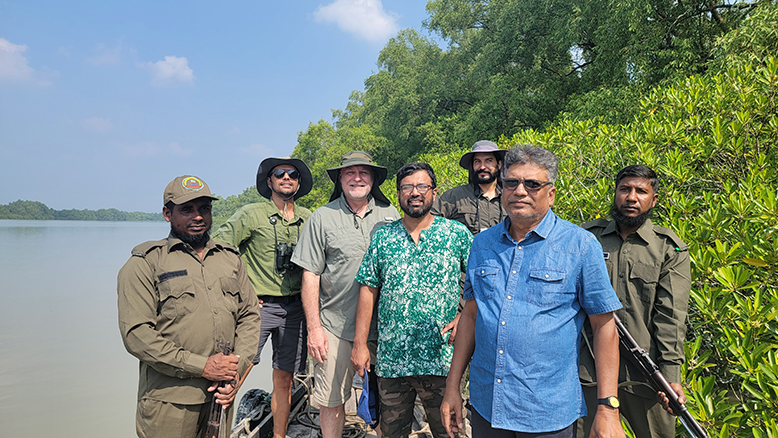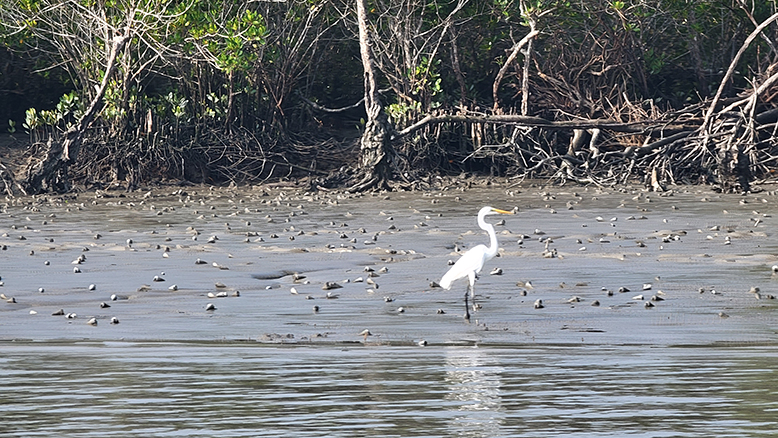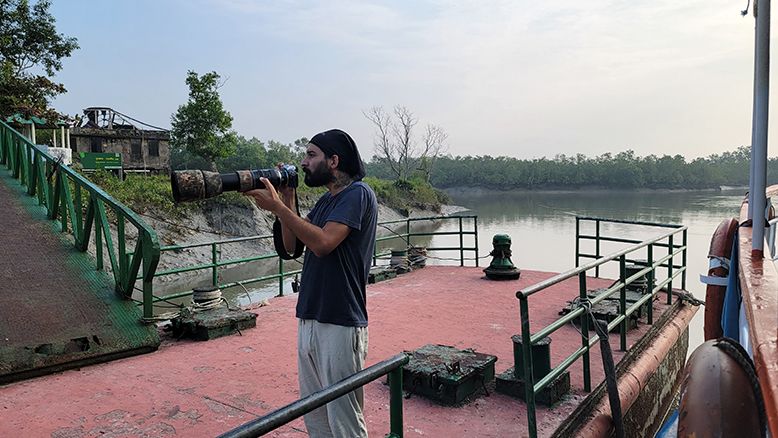Projects by Ecosystem
ACOUSTIC DATABASES BY PROJECT
The following acoustic databases have been developed by Purdue’s Discovery Park Center for Global Soundscapes. Major biome focus is listed. Recordings vary from 1 minute (for long-term recordings in international locations) to 60 minutes. The majority are 10 minutes in length (10 mins on, 50 mins off duty cycle). All files are in stereo, 44.1 or 48.0 kHz sampling rate, 16-bit depth except those in aquatic systems which are single channel and are at 96 kHz sampling rate, 16-bit depth.
Tippecanoe Soundscape Study (TEMPERATE FOREST).
Continuous passive acoustic recordings at 7 Purdue agricultural properties across a land use/cover intensity gradient designed to assess how climate change and land use affect biodiversity and soundscape diversity long-term. For 2022, recordings are from 31 sensors. Most data are for Mar-Dec each year starting 2008 to current. Database has over 550,000 recordings. Funding from EVPRO Purdue, NSF and NASA.
Aldo Leopold Land and Soundscape Ethics Study (TEMPERATE FOREST).
A 4-month study at Aldo Leopold’s shack in 2012 to study the impact of highway noise on biodiversity at a property where conservation biology was “born”. Over 23 acoustic sensors, long-term bird surveys and LIDAR data have been assembled to assess landscape structure, natural soundscape and noise patterns in this historical site. The major biome is temperate forest. The database has over 66,000 recordings. Funding from NSF.
Patagonia Soundscape Study (SUBANTARTIC).
A 3-month study was conducted in early 2016 that gathered preliminary data on (1) long-term continuous acoustic recordings of glaciers; (2) bird and mammal colonies on islands in Beagle Channel of Argentina; (3) bat behavior in Tiera del Fuego National Park and (4) elevational gradients from sub-Antarctic to Antarctic climate zones. The major biome is high latitude/Antarctic; and a longer-term (9 month) long (5) the impacts of invasive beavers on ecosystem dynamics as reflected in soundscapes. The database has over 100,000 recordings. Funding from Purdue Graduate School and Sea World.
Deep Amazonia Sentinel Study (CONTINENTAL TROPICAL MOIST FOREST).
One recorder located +100 miles in the interior of the Amazon Forest, Brazil (State of Para) has been recording since summer 2017. Database has over 20,000 recordings. Funding from NSF and Purdue EVPRO.
Platte River Basin Study (NEW WORLD GRASSLAND).
Starting in early 2015 and ending late summer 2019, we deployed 8 automated acoustic sensors at locations where University of Nebraska has been conducting a photo time lapse study (one photo per hour for 7 years). We seek to understand how grassland dynamics are altered after prescribed burns and in areas where bison are being introduced. The database has over 130,000 recordings. Funding from Purdue Graduate School, NSF and University of Nebraska.
Southern Lake Michigan Communities Project (TEMPERATE FOREST).
Twenty locations in five communities located along southern shores of Lake Michigan collected data in high traffic areas, rural forested and grassland areas and in the Indiana Dune National Shoreline for the purposes of understanding the diversity of sounds across a park-rural-urban gradient. Planners from these communities scored sound sources as those that are cultural, ecological and unwanted. The study outcome was a Soundscapes Planning Guide that is published by Purdue Extension. Funding from Indiana Department of Natural Resources. Conducted in 2018. The database has over 24,000 recordings.
Panama Caves Study (SUBTERRAIN).
A short-term study conducted in five caves at the Panamanian Smithsonian Tropical Research Institute’s properties. Five ultrasonic and five terrestrial SM4s were deployed for 1 month in May of 2018. Over 2,000 recordings were made. Funded by the Purdue Graduate School and NSF.
La Selva Biological Station, Costa Rica (NEOTROPICAL RAINFOREST).
Long-term recordings from 2008, 2011 and then for an entire year in 2015 are designed to study vertical structure of soundscape variability, the relationship between vegetation structure and soundscape complexity and the impacts of disease and climate change on amphibian populations as assess through long-term recordings. The database is over 135,000 recordings. Funding from NSF and Purdue University Faculty Scholar Program.
La Selva Biological Station, Costa Rica (TROPICAL FRESHWATER PONDS).
A six-month study to determine how aquatic acoustic dynamics vary over hourly to seasonal patterns. The database is over 5,000 recordings. Funding from NSF, Purdue Graduate School, and Purdue University Faculty Scholar Program.
Borneo Paleotropical Study (PALEOTROPICAL RAINFOREST).
As part of a 3-month long study in Brunei in 2014, over 45,000 recordings were made to understand the spatial autocorrelation of soundscapes in a global biodiversity hotspot. A second study examined how soundscape varied between 300-million-year-old forests and forested landscapes that were clear cut 15 years ago. Funding from EVPRO, NSF and University Faculty Scholar Program.
Sonoran Desert Study (SEMI-ARID DESERT WITH 6 LIFE ZONES).
We deployed over 30 acoustic recorders across 6 habitat zones and locations within zones with 3 burn severities to study how ecosystems recover from wildfire. The study, in the Chiricahua National Monument and within wilderness areas, examines soundscape patterns across a 3-year period. Daily MODIS NDVI measures are being used to assess phenological trends. Database has over 250,000 recordings and over 120,000 meteorological measurements. Funding from NSF, University Faculty Scholar Program and the National Park Service.
Wells National Estuarine Research Reserve (ESTUARY).
To understand how coastal estuaries change over time and in response to plant invasions, we deployed sensors across this research station during the summer of 2013. Sensors continued to record for two years. Database has over 41,000 recordings on land and in vernal pools. Funding from the EVPRO, University Faculty Scholar Program, and NOAA.
Denali National Park (SUBARCTIC).
Testing rigors of a variety of equipment to withstand windy and cold conditions. A short, 3-day study using 5 passive acoustic recorders. About 500 recordings and a variety of recordings of ice melting. Funding from the EVPRO and University Faculty Scholars Program.
Mongolian Steppe Study (OLD WORLD GRASSLAND).
We recorded soundscapes and grass densities in pastures of central and eastern Mongolia in 2015. A separate study was also conducted in the central mountains to determine how animal diversity was being affected by the dramatic loss of white birch forests. In 2022, an NSF sponsored study supported 31 SM4 recorders and 25 SMMicros deployed from early May through to the end of September 2022. 4 SM4 sensors serve as long-term sentinels, database has over 32,000 hours of recordings (about 125,000 recordings).
Chicago Wild Sounds Study (URBAN).
Acoustic sensors recorded from 2014 to 2016 determine how megacity noise affects bird calling behavior across the lakeshore of downtown. Another set of recorders are placed in outlying areas of the city where prairies are being restored. The database is over 35,000 recordings. Funded by NSF.
Conner Prairie Study (TEMPERATE FOREST).
We are trying to determine how landscape structure of restored prairies affects bird calling patterns during the breeding season. Also involves research on loud noise impacts on bird out-migration. The outcomes of the study are being incorporated into informal learning displays at this outdoor learning center. Database is over 15,000 recordings. Funded by Purdue Graduate School.
Dry Tortugas National Park (CORAL REEF).
We have partnered with the National Park Service to collect over 2,000 hours of recordings from two locations in the coral reef system for about 12,000 recordings. Funded by the National Park Service.
Puerto Rico Dry Forest and Coral Reef Hurricane Study (DRY FOREST and CORAL REEF).
Starting in Feb 2017, four terrestrial SM4s and 3 SM3Ms have been recording continuously outside the PR NEON site and in three reef systems in order to understand how hurricanes impact ecosystem dynamics and recovery. The two hurricanes of 2017 (Irma and Maria) were monitored and their recovery in the three reef systems and in the terrestrial dry forests. There are over 100,000 recordings spanning 2.5 years. Funded by the College of Ag Deans Office and NOAA.
Channel Island Kelp Forest Protected Area Study (KELP FOREST).
In cooperation with the National Park Service, we are studying how fishing outside a marine protected area impacts the biodiversity patterns of the marine system compared to that of protected areas. Permanent stations are being monitored where fish surveys have occurred annually since 1983. Recordings are from 2018 through to late 2020. There are over 100,000 recordings. Funded by the United States National Park Service.
Colombian Páramos and Coffee Plantation Study (TROPICAL MONTANE DRY FOREST and PÁRAMOS).
Conducted a 5-week study of the impact of mining on páramos ecosystems and another on the management practices of coffee plantations in the central valley of Colombia. There are about 10,000 recordings. Funded by the Purdue University Faculty Scholars Program and the Institute for Alexander von Humboldt.
Western Tanzania Primate Study (MIOMBO WOODLAND).
A 3 year-long study to determine how wildfire and hunting pressures affect the acoustic behavior of primates in marginal miombo woodlands. Six sentinels started collecting data in March 2017. Two intensive studies (in 2017 and then again in 2018) were conducted with 20+ sensors to understand the spatial variability of soundscapes. There are over 370,000 recordings. Funded by University Faculty Scholar Program and NASA.
Islas de Tierra del Fuego Penguin Study (SUBANTARTIC FOREST).
A six-month study examining how weather and climate impact penguin behavior and population dynamics was conducted from 2018-2019 using SM4s. There are over 35,000 recordings. Funded by University Faculty Scholar Program, Purdue Graduate School and Sea World.
Sundarbans Mangroves (MANGROVE).
A 3+ year-long study to examine the impacts of rising sea levels on mangrove biodiversity in this UNESCO World Heritage Park in Bangladesh. A combination of SM4s, SM4BATs, and SM2s with hydrophones are monitoring animal biodiversity and behavior in terrestrial and marine systems co-located at a 30-year mangrove tree diversity study being conducted by the park and the Shahjalal University of Science and Technology (SUST), Sylhet, Bangladesh. Approximately 131,000 recordings. Funded by the College of Ag Deans Office and NASA.
Avian Species Acoustic Detection Project (SUBTROPICAL FORESTS).
A three-year study to create bird species detectors for common and rare bird species at an Air Force base in Florida. Over 12,000 recordings. Funded by the US Fish and Wildlife Service.
Solar Eclipse 2018 Study (SEVERAL NORTH AMERICAN BIOMES).
A two-week study that deployed acoustic sensors along the full eclipse pathway as well as 20% and 50% pathways. Data were recorded at sites spanning the west coast of North America (Vancouver to San Jose California), central portion of the continent (Edmonton to Austin Texas), to the east coast (Charleston, SC to Orlando Florida). Approximately 10,000 recordings were made. One intensive site, at full eclipse in Nebraska, also included Canon 1D cameras and met stations. Funded by FNR Wright Fund.
Finland Boreal Soundscapes and Sense of Place Study (CONIFEROUS FORESTS).
Phase 1 was to test durability of sensors deployed at the Arctic Circle (Värriö Subarctic Research Station). Two sensors recorded over 56,00 recordings from May 1 to Dec 15, 2022 (while also recording voltage and air temperatures). Starting in April 2023, over 30 sensors will be deployed in remote areas of Finland including the Värriö Subarctic Research Station starting in April 2022. Collaborators include faculty and students at the University of Helsinki. Funded by the University of Helsinki and College of Agriculture Dean’s Office.
Sounds of Wine Making (CHAPARRAL and TEMPERATE FORESTS).
Twelve sensors are installed in California (Napa) and Indiana (central counties) vineyards with half of them in the vineyard and the other half in natural areas surrounding the vineyards. Study initiated in late summer of 2021 and then re-deployment was done in May 2022. Around 28,000 recordings were made. Funded by the Purdue Graduate School and Purdue Extension.
Biomes yet to be studied as of February 2024, include: tundra/subarctic, spiny forest, temperate rainforest.
Trips Around the World
















View Clips From Our Travels:

 @CenterforGlobalSoundscapes
@CenterforGlobalSoundscapes